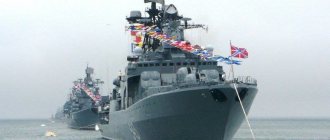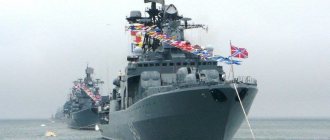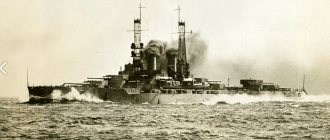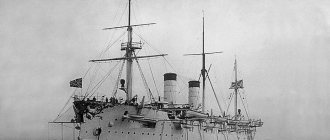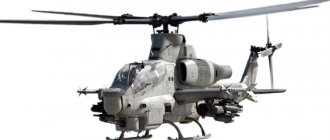Navy business card
Since the early 80s of the last century, 27 Ticonderoga-class guided missile cruisers have been a unique calling card of the US Navy. These ships, with a total displacement of 9,800 tons each, in order to speed up the design, as well as comply with the conditions of standardization and unification, were created on the basis of the hull and mechanisms of the Spruance-class destroyer. At the same time, the Ticonderogas received a number of truly revolutionary new products: a main power plant in the form of four General Electric LM2500 gas turbine engines with a total power of 80,000 hp. pp., unified shipborne vertical launch systems (VLS) for guided missiles and the Aegis combat information and control system.
As their creators wanted, the Ticonderogas became universal ships - they could equally effectively hunt submarines, launch powerful missile attacks on enemy ships and ground targets, and also provide air defense for aircraft carriers and landing forces. After modernization in 2000-2011, the cruisers were able to use RIM-161 Standard Missile 3 interceptor missiles, which turned the Ticonderoga into an element of the American missile defense system.
wikipedia.org / Mass Communication Specialist Seaman Jonathan Pankau / Public Domain
In general, Ticonderogas were good for everyone, but their service life turned out to be finite. In 2004-2005, the first five cruisers of the series were decommissioned. In 2017, Defense News published information that in 2020-2026, 11 more Ticonderogs would be removed from the American fleet and sent for disposal. Ultimately, cruisers of this type will disappear from the US Navy by the mid-40s of the 21st century. It should be understood that the decommissioning of each Ticonderoga immediately removes 122 UVP cells from the arsenal of the American fleet, from which it is possible to launch both Tomahawk cruise missiles and ASROC anti-submarine guided missiles or anti-aircraft guided missiles, including the already mentioned RIM-161 Standard Missile 3.
Taking this into account, it is quite natural that the Pentagon has repeatedly thought about what kind of ships in the future could replace the legendary Ticonderogas in the US Navy.
Anti-submarine defense
The cruiser has a full range of anti-submarine weapons, which are traditionally installed on board large surface ships. It includes:
- active underbody sonar type AN/SQS-53;
- towed low frequency antenna TACTAS;
- two anti-submarine helicopters of the SH-60 family;
- anti-submarine missiles RUM-139 ASROC-VL
- Max. firing range is 22 km, warhead
- small-sized deep-sea torpedo MK.54;
- two torpedo tubes for launching small-sized torpedoes (324 mm caliber). Its purpose is to combat submarines in the immediate vicinity of the ship.
PLO is a network task; it cannot be solved by one ship. In this sense, Ticonderoga is an important component of the anti-submarine defense order.
"Little Lousy Boat"
Initially, the Americans relied on the construction of three new types of ships at once. The first of them was designated as a “littoral combat ship” (Littoral Combat Ship) and, according to the original idea, was a small, high-speed, inconspicuous “stealth” ship for operations in the near sea zone. For operations in the far sea zone, the types of ships that were developed within the framework of the “Program for the creation of a surface combatant of the 21st century” and were something like arsenal ships were intended. The promising destroyer URO DD-21 was supposed to have a total displacement of 14,000 tons and carry up to 128 UVP. The displacement of the promising cruiser URO CG-21 “ran away” beyond 16,000 tons, but it would have had two hundred UVP. At the same time, DD-21 and CG-21 were also supposed to be “stealth”, like the small “Litori” LCS.
Then everything worked out for the Yankees in strict accordance with the Russian proverb: “it was smooth on paper, but they forgot about the snags.”
Firstly, the command was unable to choose any one option from the LCT projects proposed for the competition, so the “Litoriashki” began to be built according to two projects at once, which significantly increased the cost of building the planned series of six dozen LCS.
Secondly, the small size of the LCS did not allow the placement of sufficiently powerful weapons on these ships, so naval wits began to decipher the abbreviation LCS as Little Crappy Ship - “little lousy boat.”
Thirdly, the tactical and technical characteristics of the first four LCS, as well as the quality of their construction, turned out to be so low that the Yankees decided to quickly write off these completely new ships.
wikipedia.org / US Navy photo by Mass Communication Specialist 2nd Class Antonio P. Turretto Ramos / Public Domain
Fourthly, with the end of the Cold War, the Pentagon abandoned the construction of CG-21 type guided missile cruisers, and funding for the DD-21 type guided missile destroyer project was cut by 50%. In order to maintain an acceptable level of innovations included in the project (“stealth” technologies, a gun mount with active rockets, and so on), as well as the number of destroyers expected to be laid down (more than 30 units), the designers seriously cut down the characteristics of the promising destroyer. Thus, the promising URO destroyer, called "Zumvolt", with a total displacement of 14,797 tons, carried only 80 missiles. Compared to the Ticonderoga, which was half the size, it was, frankly speaking, not a lot.
Fifthly, the cost of building the Zumvolts turned out to be so fantastic that by the beginning of 2022, the States were able to launch only three such guided missile destroyers, after which they began to think hard about whether it was necessary to build such ships at all? After all, with the cost of building the first three Zumvolts being $12.73 billion, these ships were inferior in their strike potential of 240 missiles to the two Ticonderogas (244 missiles), which were much smaller in size and cost only a couple of billion dollars!
Sixth, the above-described “creative” throwing of the Pentagon not only completely violated the principles of standardization and unification that were strictly observed during the design and construction of the Ticonderogas, but also did not allow the creation of ships that, at least in theory, could serve as a full-fledged replacement for the universal Ticonderogas.
Air defense system
All hopes are placed on the Aegis BIUS (Aegis), which connected computers, radars and fire control systems into a single network.
The main component of the Aegis is the AN/SPY-1 multi-purpose radar with four fixed phased arrays. Operating range: decimeter (S). The peak radiation power is 6 megawatts, which allows the radar to distinguish targets in low-Earth orbit.
SPY-1 performs search by azimuth and elevation, acquisition, classification and tracking of targets, control of autopilots of anti-aircraft missiles on the launch and sustaining sections of the flight path.
The only problem with SPY-1 is that the radar has difficulty distinguishing fast-moving targets flying near the surface of the water.
The fire control system is archaic, based on four SPG-62 target illumination radars. It is curious that in this aspect, Ticonderoga again has an advantage over Arleigh Burke (4 radar illumination versus three for the destroyer).
The main fatal drawback of the SPG-62 is mechanical scanning (turn speed 72°/sec). At any given time, each radar is capable of highlighting only one target. As a result, if the capabilities of SPY-1 allow you to control up to 18 fired anti-aircraft missiles, then only 4 air targets can be attacked simultaneously (and, most importantly, no more than two from each side).
The only advantage of this scheme: unlike dozens of beams of new-fangled AFARs and missiles with active seekers, the outdated illumination radar has a directional pattern with a narrow main lobe, which allows for effective and highly selective illumination of the target in conditions of the use of electronic warfare equipment.
Currently, the small number of illumination channels is offset by the appearance of anti-aircraft missiles with active homing (SM-3, SM-6, ESSM Block-II).
BOD "Marshal Shaposhnikov" against the backdrop of the clumsy-looking USS Chosin (CG-65)
Selection of targets, assessment of threats, control of the sequence of fired anti-aircraft missiles - this is the purpose of the Aegis system. In real conditions, the theory failed, and the first battle turned out to be lumpy. In the confusion of the battle with the Iranian Navy, the cruiser Vincennes overwhelmed the civilian Airbus.
However, three decades have passed. American Aegis ships spent a total of 1,250 years in combat campaigns, firing over 3,800 missiles during combat and training missions . One must assume that they learned something.
In addition to four SPY-1 plates and four SPG-62 target illumination radars, the complex of cruiser detection equipment includes an auxiliary station SPS-49. Two-dimensional L-band surveillance radar with a rotating parabolic antenna. Currently recognized as completely obsolete, there is a project to replace it with the SPQ-9B (Back-to-Back Slotted Array) radar with two phased arrays operating in the centimeter range. The appearance of this device promises to “cure” one of the main shortcomings of the Ticonderoga - the problem of detecting low-flying targets.
The cruiser's anti-aircraft arsenal is located in the bow and stern launchers of the MK.41 type; the number and type of missiles vary depending on the mission. Theoretically, the cruiser is capable of carrying up to a hundred anti-aircraft missiles (with the possibility of maintaining moderate versatility by placing it in the remaining Tomahawk and ASROK missile silos).
The nose group of the UVP is visible
The ammunition load includes the following types of ammunition:
- SAM of the "Standard" family . The latest modifications of the RIM-156 SM-2ER and RIM-174 ERAM (with an active head from the air-to-air missile) are, in theory, capable of intercepting targets at a distance of 240 km from the ship;
- exotic RIM-161 "Standard-3" , whose interception altitude extends beyond the stratosphere. The SM-3 is focused exclusively on missile defense missions and is not intended against “conventional” aerodynamic targets. The scheme implements kinetic interception (direct hit on the target). External illumination for space purposes is not required (and is impossible) - the SPY-1 radar guides the missile to a given area of space, then SM-3 orients itself using an infrared seeker;
- RIM-162 ESSM medium/short-range anti-aircraft missile with an effective firing range of 50 km. Optimized for intercepting high-speed, low-flying targets (anti-ship missiles). Thanks to its unusual layout and the presence of a deflectable thrust vector, the ESSM is capable of maneuvering with overloads of up to 50g. The missiles are stored on board the cruiser, four in one launch cell.
The near line of defense is formed by two Phalanx anti-aircraft guns. The main advantage of automatic anti-aircraft guns is the presence of their own radar and complete independence from other ship systems (except for power supply). Disadvantage (common to all such systems): there is a threat that the Phalanx will be useless in a real battle. The fragments of missiles shot down in the near zone will fly by inertia and fatally cripple the ship.
As a “last chance” weapon, there are 70 sets of Stinger MANPADS on board.
General conclusions: due to the selected range and power of the radar, the Ticonderoga air defense system is ideally suited for intercepting targets in the upper atmosphere. At the same time, there is a whole range of problems with intercepting low-flying targets.
However... Only the Zamvolt and several European and Japanese destroyers have more effective near-zone air defense compared to the Ticonderoga.
Project 58 missile cruisers (code "Grozny")
1962 Total displacement 5,500 tons. Crew 340 people. Full speed – 34 knots. Cruising range - 3500 miles (at 18 knots). Armament: - anti-ship complex P-35 (2 launchers, ammunition 16 anti-ship missiles); — short-range air defense system M-1 “Volna” (16 anti-aircraft missiles); — two automatic twin guns of 76 mm caliber; — 6 torpedoes of 533 mm caliber; — 2 x 12 RBU-6000 rocket launchers; - Helipad
0
Nikita Khrushchev's favorite ship. A small Soviet cruiser with colossal striking power for its size. The world's first warship equipped with anti-ship missiles. Even with the naked eye it is noticeable how overloaded the baby was with weapons - according to the plans of those years, “Grozny” had to almost alone carry out watches in the far latitudes of the World Ocean. You never know what tasks may arise for the Soviet cruiser - “Grozny” must be ready for anything! As a result, a universal weapon system appeared on board the ship, capable of fighting any air, surface and underwater targets. Very high speed - 34 knots (more than 60 km/h), universal artillery, equipment for receiving a helicopter... But what was especially impressive was the P-35 anti-ship complex - eight four-ton blanks, capable of falling off the guides at any moment and rushing beyond the horizon at supersonic speed (firing range - up to 250 km). Despite doubts about the long-range target designation capabilities of the P-35, powerful electronic countermeasures and anti-aircraft fire from American AUGs, the cruiser posed a mortal threat to any enemy squadron - one of the four missiles from each launcher had a megaton “surprise”. Advantages: — exceptionally high saturation with fire agents; - great design. Disadvantages: Most of the disadvantages of the Terrible were in one way or another related to the desire of the designers to place the maximum number of weapons and systems in the limited hull of the destroyer. — short cruising range; — weak air defense; - imperfect weapon control systems; — fire hazardous design: aluminum superstructure and synthetic interior finishing.
0
USSR naval power
0
Artillery and auxiliary weapons
The cruisers are armed with two universal MK.45 cannons of 127 mm caliber. A compact artillery system with no outstanding characteristics. 16-20 shots per minute, firing range 13 miles (24 km). Due to the low power of 5'' shells, they are only suitable for firing at Iranian corvettes and finishing off wounded fighters.
Artillery fire is adjusted according to AN/SPQ-9 radar data.
After the incident with the Cole EM, a pair of 25 mm automatic Bushmasters appeared on board the cruisers to fire at the terrorists’ high-speed boats.
Electronic warfare equipment
On board there is a standard electronic warfare complex for all American ships for conducting electronic reconnaissance and suppressing SLQ-32 missile guidance systems with a maximum radiation power of 1 megawatt (antenna devices are mounted on two “balconies” in the central part of the superstructure).
There is a system for shooting dipole reflectors MK.36 SRBOC and a towed anti-torpedo trap (“rattle”) SLQ-25 “Nixie” (projected overboard through the lapports in the stern of the ship). Taking into account the results of military clashes at sea over the past half century, it is electronic warfare equipment that is an “insurance policy” and the most effective means of protection on board a ship.
There is nothing else on board the cruiser that is worth talking about.
Missile cruiser Long Beach
1961 Total displacement 17,000 tons. Crew 1160 people. Full speed - 30 knots. Cruising range - 360,000 miles. Armament: - Terrier medium-range air defense system (2 launchers, 102 missiles ammunition) - Talos long-range air defense system (1 launcher, 52 missiles ammunition) - ASROC anti-submarine missile system (24 missile torpedoes ammunition) - two universal 127 mm caliber guns; - two Phalanx anti-aircraft guns, 8 Harpoon anti-ship missiles, 8 Tomahawk missiles (modernized in the early 1980s).
0
The world's first nuclear-powered cruiser is undoubtedly worthy of mention in the list of the best ships of the 20th century. In combination, Long Beach became the world's first specialized missile cruiser - all previous designs (Boston-class missile cruisers, etc.) were just improvisations based on artillery cruisers of World War II. The ship turned out to be gorgeous. Three missile systems for various purposes. The unusual “box-shaped” shape of the main superstructure, dictated by the installation of SCANFAR phased radars, also unique radio systems of its time. Finally, the nuclear heart of the cruiser, which made it possible to accompany the nuclear aircraft carrier Enterprise everywhere, for interaction with which this miracle was created. However, an incredible price was paid for all this - 330 million dollars (about 5 billion at the current exchange rate!), In addition, the imperfection of nuclear technology did not allow the creation of a compact nuclear power system of the required power in the 50s - the cruiser rapidly “grew” in size, finally reaching 17 thousand tons. Too much for an escort ship! In addition, it turned out that Long Beach did not have the opportunity to realize their advantage in practice. Firstly, the ship's autonomy is limited not only by its fuel reserves. Secondly, the aircraft carrier’s retinue included many ships with conventional power plants, which made it difficult for the nuclear cruiser to move quickly.
0
Long Beach served honorably for 33 years. During this time, he left a million nautical miles astern, while managing to fight in Vietnam and Iraq. Due to its exceptional complexity and cost, it remained the lonely “white elephant” of the fleet, however, it had a significant influence on the development of world shipbuilding (including the birth of our next “hero”). Advantages of Long Beach: - unlimited autonomy in terms of fuel reserves; — radars with phased array; - versatility. Disadvantages: - monstrous cost; - less survivability compared to conventional cruisers.
0
external links
- Description on the Modern Warships page
- Description on the Global Security website
- gallery
| Arleigh Burke type destroyers |
|
| Congo type destroyers |
|
Aviation weapons
In stormy weather, Ticonderoga has one subtle but extremely important advantage over any other cruiser or destroyer. Its helipad is located in the middle part of the ship - where the amplitude of vibrations during pitching is less.
To facilitate landing and movement of helicopters on deck in stormy weather, all cruisers are standardly equipped with the RAST system.
There is a hangar designed for two anti-submarine helicopters of the SH-60 Sea Hawk family.
The aviation weapons cellar stores up to 40 small-sized anti-submarine torpedoes, light Penguin anti-ship missiles, NURS units and ammunition for aircraft guns.
